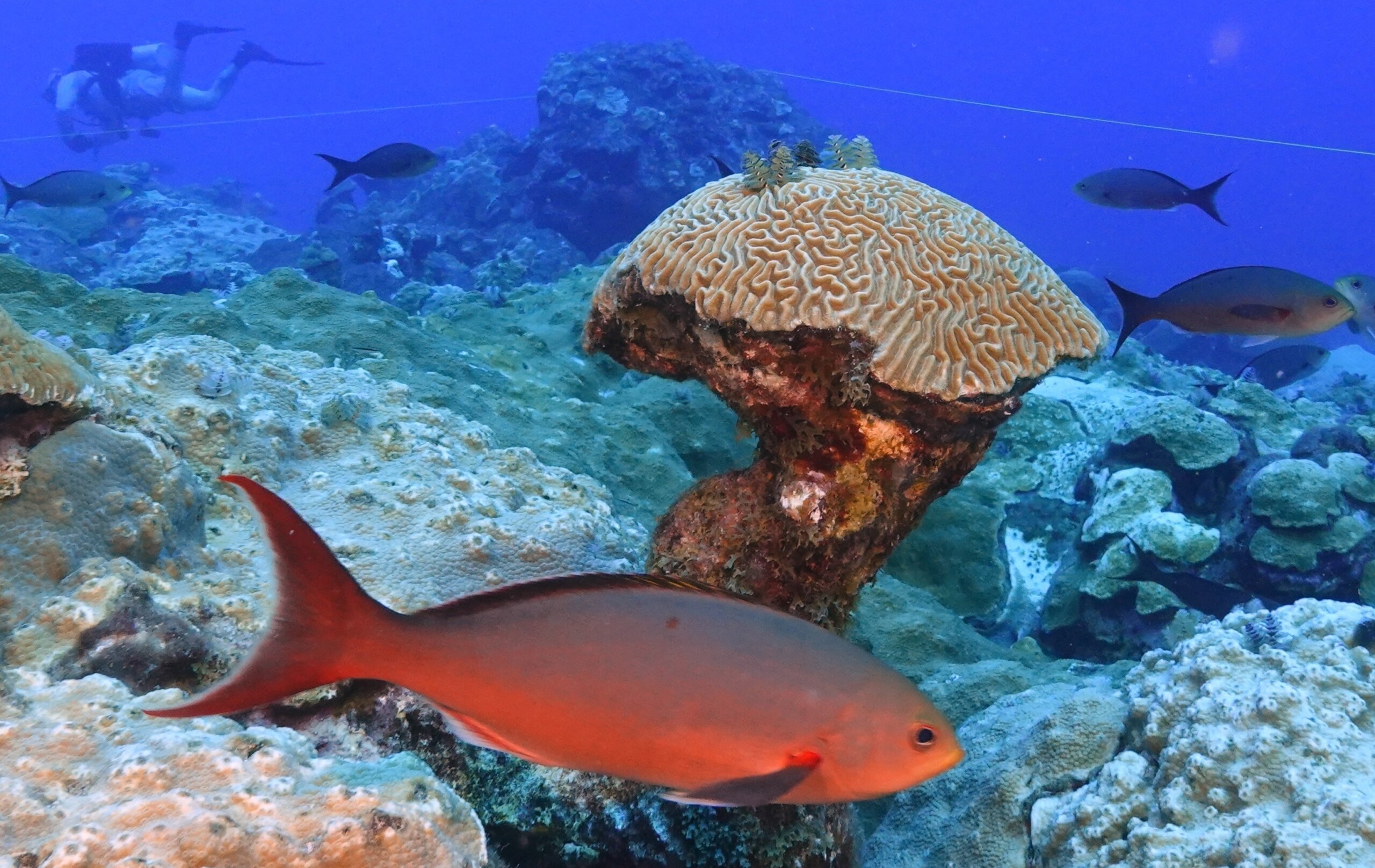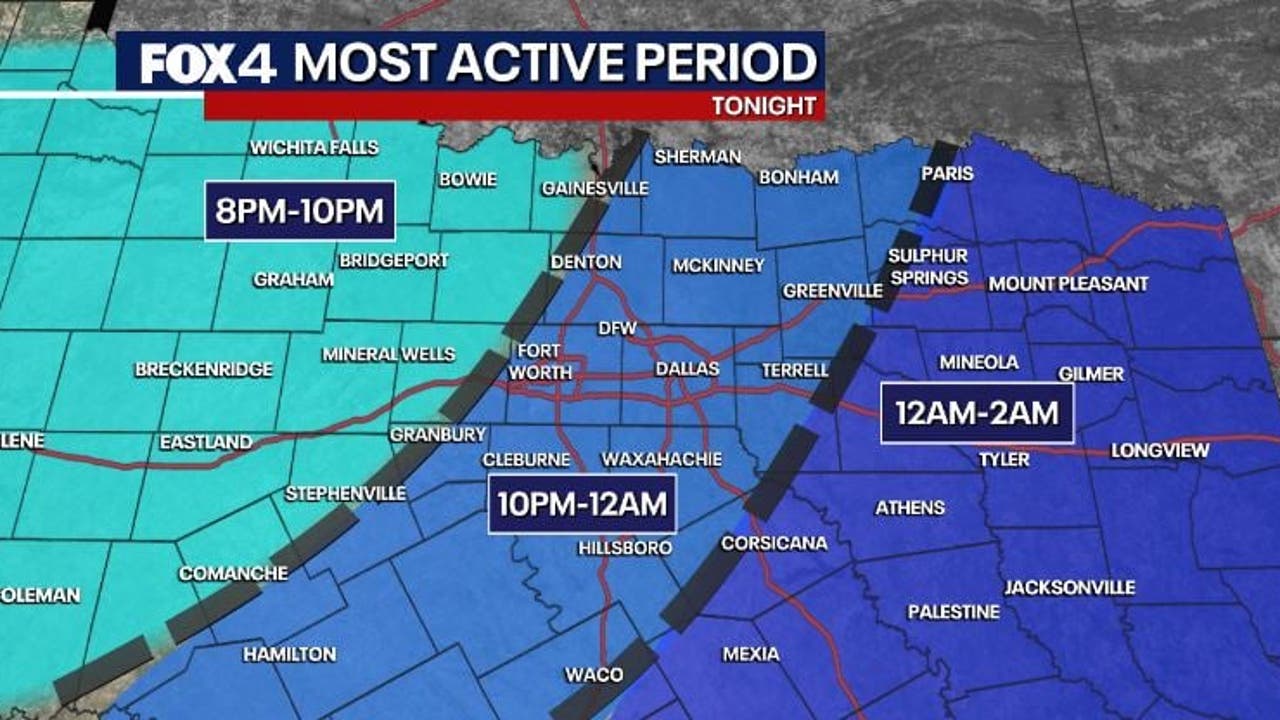Texas
Climate change is hurting coral worldwide. But these reefs off the Texas coast are thriving – WTOP News

OFF THE COAST OF GALVESTON, Texas (AP) — Divers descending into azure waters far off the Texas coast dip below…
OFF THE COAST OF GALVESTON, Texas (AP) — Divers descending into azure waters far off the Texas coast dip below a horizon dotted with oil and gas platforms into an otherworldly landscape of undersea mountains crusted with yellow, orange and pink coral as far as the eye can see.
Some of the world’s healthiest coral reefs can be found in the Gulf of Mexico, about 100 miles (160 kilometers) off the Texas coast. Sheltered in a deep, cool habitat far from shore, the reefs in the Flower Garden Banks National Marine Sanctuary boast a stunning amount of coral coverage. But scientists say that like all reefs, they are fragile, and their location will only offer protection for so long in the face of a warming climate.
“To see that much coral in one place is really magnificent — an experience that most people don’t get on reefs in this day and age,” said Michelle Johnston, the acting superintendent and research coordinator for the federally protected area.
The sanctuary had some moderate bleaching this year but nothing like the devastation that hit other reefs during the summer’s record-breaking heat. Still, Johnston said that’s among her top concerns for the sanctuary’s future. Waters that get too warm cause corals to expel their colorful algae and turn white. They can survive if temperatures fall but they are left more vulnerable to disease and may eventually die.
Florida’s coral reef — the world’s third-largest — experienced an unprecedented and potentially deadly level of bleaching over the summer. Derek Manzello, coordinator of the National Oceanic and Atmospheric Administration’s Coral Reef Watch, said that so far this year, at least 35 countries and territories across five oceans and seas have experienced mass coral bleaching. He said it’s too early to know how much of Florida’s reefs will recover since coral may die as much as a year or two after the bleaching.
Manzello said climate models suggest that all of the world’s coral will be suffering severe bleaching every year beginning around 2040.
“If you have severe bleaching events every year, the prognosis is not good because that basically means the corals aren’t going to have a chance to recover,” he said.
Sanctuary officials say even in the occasional years when Flower Garden Banks has experienced more serious bleaching than this year, it has bounced back quickly thanks to its overall health and depth, and it’s already recovering this year.
A report expected in the coming months will look at the sanctuary’s vulnerability to the projected effects of climate change.
The Flower Garden Banks stands out for its amount of coral cover — an average of over 50 percent across some areas of the sanctuary — compared with around 10 percent cover in the Caribbean and Northwest Atlantic region, Manzello said. Its corals are also about 60 feet (18 meters) below the surface and surrounded by even deeper waters, compared with many reefs where corals are in shallower water just offshore.
In the early 1900s, fishermen told of peering into the Gulf’s waters and seeing a colorful display that reminded them of a blooming garden, but it was such an unusual spot so far from shore that scientists making the initial dives in the 1960s were surprised to actually find thriving coral reefs.
The corals in the Flower Garden Banks were able to flourish so far from shore because of mountain-like formations called salt domes, which lifted the corals high enough to catch the light, Johnston said.
Divers travel from around the world to see the reefs at Flower Garden Banks, where colorful fish, manta rays, sharks and sea turtles waft through and worms that look like Christmas trees pop in and out of corals.
Andy Lewis, a Houston attorney, said he knew from his first trip to the sanctuary about a decade ago that it was “going to have to be part of my life.” Lewis became a divemaster and is now president of Texas Caribbean Charters, which takes about 1,000 people a year out on diving trips there, with about half making a return trip.
“It’s just a real adventure,” said Lewis, who also serves on the sanctuary’s advisory board. “I love getting on the boat.”
That boat leaves from a spot near Galveston, where currents from Mississippi River drop sediment that turns the water near shore a murky brown. By the time the boat motors out to the sanctuary, the water is clear and blue.
“You drop down and you are on top of live coral as far as you can see,” Lewis said.
Lauren Tinnes, a nurse from Colorado, described rounding a bluff on her dive this fall and being surrounded by massive reefs as schools of fish darted through. She found the description from so long ago apt: “It’s like a field of flowers,” she said.
The Flower Garden Banks is one of 15 national marine sanctuaries and two national marine monuments protected by the NOAA’s Office of National Marine Sanctuaries, and the only one in the Gulf of Mexico.
The sanctuary is made up of 17 separate banks that cover 160 square miles (414 square kilometers). When it was designated in 1992, the sanctuary had two banks. Its largest and most recent expansion of 14 banks came in 2021, a process that included input from the advisory committee, which includes representatives from industries that rely on the Gulf, from oil and gas to recreation to fishing.
Johnston said that one way to help the reefs stay healthy is to reduce stresses. That includes making sure mooring buoys offer boats a place to tie up so their anchors don’t damage reefs, and removing invasive species that could cause the number of fish to decline.
Manzello said efforts like those are being done in hopes that greenhouse gas emissions will also be cut globally.
“We need all of these things happening in concert to really shepherd coral reefs through the next 20, 30, 40 years,” Manzello said.
Coral reefs support about a fourth of all marine species at some point in their life cycle. They are also economic drivers. By providing a home for fish that keeps them healthy, they support commercial fishing in addition to bringing in tourism revenue.
“Because coral reefs are declining all over the globe, when we find ones that are healthy, we want to keep them that way,” said Kelly Drinnen, education and outreach specialist for the Flower Garden Banks. “And they kind of serve as the repositories for what could help restore some other reef potentially in the future.”
In fact, samples of healthy corals from the sanctuary are being banked and studied in a lab at Galveston Island’s Moody Gardens, a tourist destination that includes an aquarium. That includes growing out fragments of coral with hopes of someday replanting them.
The Flower Garden Banks weren’t damaged by the massive oil spill that followed the deadly 2010 explosion on the Deepwater Horizon drilling rig, but other reefs in the Gulf were. Data gathered from studying the sanctuary’s deeper habitat is being used to help guide restoration of those reefs.
Researchers are also studying the genetics of the Flower Garden Banks coral, including whether it’s different than species in Florida.
“The more knowledge we have, the better we are equipped to try to protect that reef,” said Brooke Zurita, a senior biologist at Moody Gardens.
___
Stengle reported from Dallas. LaFleur reported from Galveston.
___
Associated Press climate and environmental coverage receives support from several private foundations. See more about AP’s climate initiative here. The AP is solely responsible for all content.
Copyright
© 2023 The Associated Press. All rights reserved. This material may not be published, broadcast, written or redistributed.

Texas
Hundreds protest in Austin against nationwide ICE detentions
:focal(0x0:3000x2000)/static.texastribune.org/media/files/d3fa61a31060a00ce4f21c81921951cf/0609%20Austin%20Ice%20Protest%20RB%20TT%2003.jpg)
Sign up for The Brief, The Texas Tribune’s daily newsletter that keeps readers up to speed on the most essential Texas news.
A largely peaceful march in downtown Austin on Monday condemning the uptick in immigrant detentions across the country dispersed when law enforcement fired tear gas into a portion of the crowd that refused to leave.
The protest, organized by the Party for Socialism and Liberation’s Austin branch, began outside state Capitol grounds at around 7 p.m. as several hundred protesters condemned raids conducted in recent weeks by U.S. Immigration Customs and Enforcement. The group guided the mile-long march and chants through downtown toward the J. J. “Jake” Pickle Federal Building before circling back to the Capitol.
While the organizers announced the end of their gathering just after 8 p.m., more than a hundred protesters continued marching as police told them to leave the streets. Some rerouted back to the federal building but were blocked from it by law enforcement, who eventually fired tear gas canisters into the crowd.
Speakers during the protest and those who marched in downtown Austin said ICE and law enforcement were operating without due process for people they have detained in raids. Some, including Valerie Cruz, an Austin resident and first generation American, came to share their solidarity with undocumented immigrants they say have been villainized by law enforcement.
“I had the privilege of my family being able to come here ‘the right way,’ you know what they say, right? And not everybody has that privilege, not everyone has that luxury, and that’s why I’m here,” Cruz said.
A protest in Dallas also occurred on Monday evening, following two others on Sunday in San Antonio and Houston. All four were inspired by protests against ICE in Los Angeles over the weekend, which started after a series of ICE immigration sweeps and arrests sparked outcry from locals, according to CalMatters.
/https://static.texastribune.org/media/files/c538d23f920120a3f221b85d370ef3be/0609%20Austin%20Ice%20Protest%20RB%20TT%2007.jpg)
Protesters bang their fists and write messages on the doors at the entrance of the J.J. “Jake” Pickle Federal Building during a protest against ICE in Austin on Monday.
Credit:
Ronaldo Bolaños/The Texas Tribune
State and federal authorities have escalated their presence in Los Angeles as protests have continued. The Pentagon on Monday deployed 700 Marines to Los Angeles hours before protesters gathered in Austin. Those Marines are in addition to the 2,000 National Guard troops sent by the Trump administration to Los Angeles.
California Gov. Gavin Newsom called the deployment of law enforcement into Los Angeles an “unmistakable step toward authoritarianism” in a news release on Monday. Newsom is now suing the administration for the guard’s deployment.
SUBSCRIBE NOW
Austin Police Department and Texas Department of Public Safety officers gathered and at times surrounded the protesters as they moved through downtown. At one point, a DPS officer fell off their motorcycle while attempting to corral protesters, and shortly afterward, another officer shot pepper spray at a protester who was not near the fallen motorcycle. That protester, who did not wish to be named, was incapacitated after being sprayed in their face.
According to one eyewitness, at least two people were detained, but APD and DPS did not immediately respond to requests for confirmation. It was also unclear whether anyone was injured by the tear gas.
/https://static.texastribune.org/media/files/56b7f35ed452b5073d2d86dd94e5be1f/0609%20Austin%20Ice%20Protest%20RB%20TT%2001.jpg)
A Department of Public Safety officer sprays a chemical deterrent at a protester during a demonstration against ICE in downtown Austin on Monday. The spray was used after a DPS officer lost control of their bike in the crowd.
Credit:
Ronaldo Bolaños/The Texas Tribune
Big news: 20 more speakers join the TribFest lineup! New additions include Margaret Spellings, former U.S. secretary of education and CEO of the Bipartisan Policy Center; Michael Curry, former presiding bishop and primate of The Episcopal Church; Beto O’Rourke, former U.S. Representative, D-El Paso; Joe Lonsdale, entrepreneur, founder and managing partner at 8VC; and Katie Phang, journalist and trial lawyer.
Get tickets.
TribFest 2025 is presented by JPMorganChase.
Texas
Former Dallas Cowboys player leaves scene of fatal crash, Texas police say

RICHARDSON, Texas — A former player for the Dallas Cowboys is facing criminal charges after police say he struck and killed a motorcycle rider while driving drunk, then left the scene.
A news release from the Richardson Police Department says Kelvin Joseph Jr., 25, of Allen, Texas, is charged with driving while intoxicated, a misdemeanor, and collision involving personal injury or death, a second-degree felony.
The crash occurred just before 5 a.m. Saturday on the North Central Expressway, police say. The driver of the motorcycle, Cody Morris, a 27-year-old woman from Plano, Texas, died at the scene.
About 45 minutes later, Joseph reportedly contacted police and said he had been involved in the crash while driving his BMW sedan. Police say Joseph showed signs of being intoxicated while he spoke with officers.
WFAA Channel 8 reports Joseph was released from jail Sunday morning.
The Cowboys drafted Joseph, a defensive back, in the second round of the 2021 NFL Draft. He played only two seasons with the Cowboys, then was traded to Miami. He also has played for Seattle and Indianapolis.
According to the Dallas Morning News, Joseph currently is playing for the DC Defenders in the United Football League. The Morning News reports that in March 2022, Joseph was in an SUV from which two people fired shots into a group of people in a parking lot. Police determined Joseph was not a shooter, the Morning News reports.
Texas
Dallas weather: Severe weather expected across North Texas

DALLAS – North Texas is facing a significant severe weather event Sunday night, with the potential for widespread damaging winds, large hail, and possible tornadoes.
Sunday Forecast
Big picture view:
The primary threat will be powerful, straight-line winds, with gusts potentially reaching 80 to 95 mph as a line of storms moves through the region. The Storm Prediction Center has issued a Level 4 out of 5 “moderate risk” for a large portion of North Texas, indicating the potential for a significant severe weather outbreak.
“This has the potential to be one of the greatest severe weather events that we’ve seen so far this spring, just with that high wind potential,” Capps said. She noted that winds of that magnitude can cause damage equivalent to an EF-0 or EF-1 tornado.

Timeline:
The line of storms is expected to approach northwestern North Texas around 8 p.m. and move into the Dallas-Fort Worth Metroplex between 10 p.m. and midnight. It is forecast to exit the area to the east and southeast between 1 a.m. and 2 a.m. Monday.
“The initial storms that move in from the north and west will have that tornado threat, as well as a large hail threat, but wind continues to be the greatest concern,” Capps said. An increasing flood threat is also a concern due to the potential for heavy rainfall.
Live Radar

Earlier Sunday, scattered showers and some thunderstorms were reported in the far eastern and northeastern parts of North Texas, with some storms crossing the Red River producing hail.
Daytime hours on Sunday are expected to be hot and humid before the storms arrive. High temperatures are forecast to reach the low to mid-90s, with a heat index making it feel like 100 to 104 degrees.
The active weather pattern is expected to continue through the week. Multiple rounds of showers and thunderstorms are in the forecast from Tuesday through Thursday, bringing a continued threat of heavy rain and potential flooding.
7-Day Forecast

Residents are advised to stay weather-aware, have multiple ways to receive warnings, and secure outdoor objects that could become projectiles in high winds.
The Source: Information in this article is from the FOX 4 Weather Team.
-

 Politics1 week ago
Politics1 week agoMichelle Obama facing backlash over claim about women's reproductive health
-

 Finance1 week ago
Finance1 week agoHere's what will boost your feeling of financial well-being the most, researchers say
-

 West3 days ago
West3 days agoBattle over Space Command HQ location heats up as lawmakers press new Air Force secretary
-

 Technology1 week ago
Technology1 week agoWhy do SpaceX rockets keep exploding?
-

 World1 week ago
World1 week agoTwo killed in Russian attacks on Ukraine before possible talks in Turkiye
-

 World1 week ago
World1 week agoNcuti Gatwa Bids Doctor Who Farewell as Finale Ends With a Most Surprising Twist — Grade It!
-

 News1 week ago
News1 week agoTrump administration continues to target international students. What to know and what could be next.
-
Vermont1 week ago
MMU’s Bea Molson returns to glory, CVU girls claim doubles at tennis championships















